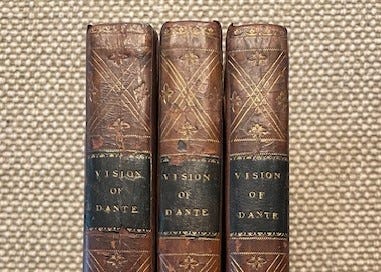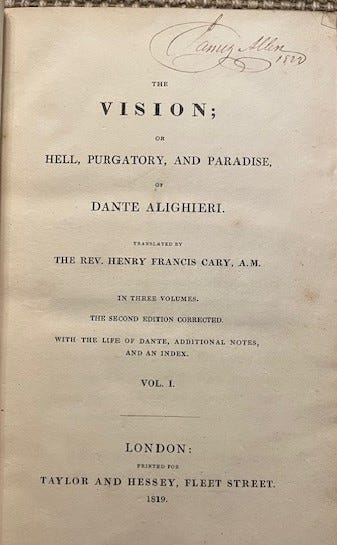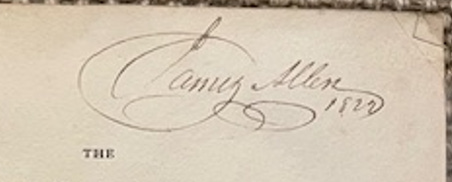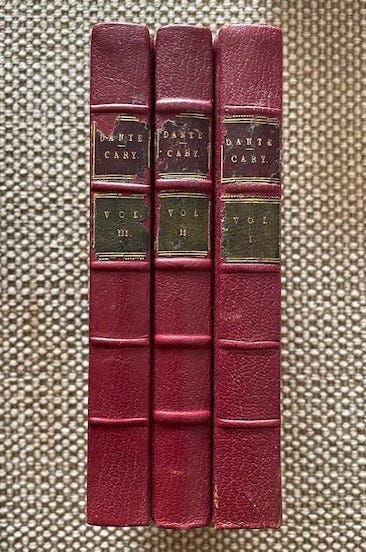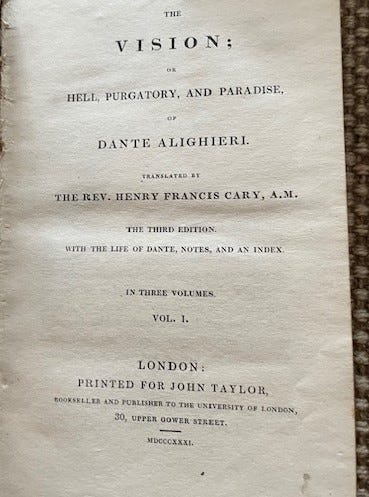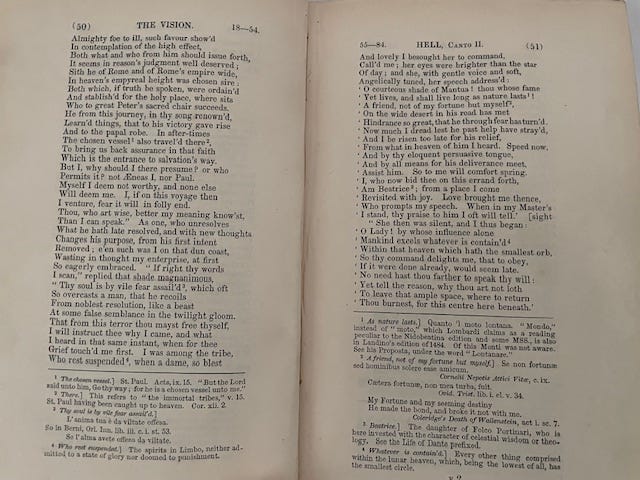Before I continue with my chronological list of Dante translations I wanted to finish up going over the rest of Cary’s editions, the ones published in his lifetime.
To recap Part 1:
Due to low sales of his Inferno, published in 1805-06, Cary was not able to find a publisher for his Divine Comedy, so he funded the printing cost himself in 1814. There was a second issue of the 1814 edition, but I argue that in reality it couldn’t have been released until 1818. Go read the previous post Big Daddy Cary's Divine Comedy: Part 1 for the details.
It was in 1819 Cary published his second edition, the third in 1831, and the fourth, the last published in his lifetime, 1844. There are a ridiculous amount of post-1844 editions for sale online, some at absurd prices. I will delve into that in another post.
1819 - Henry Francis Cary - Divine Comedy - Second Edition
In 1818 Taylor and Hessey approached Cary to publish the second edition of the his translation of the Divine Comedy. In the agreement they (T & H) were to buy “for £109 the remainder of the old editions (about a thousand copies) [the 1814 edition].”1 They also agreed to “pay £125 for the new [second] edition of 750 copies.”2
It was in July of 1819 Cary’s Comedy was once again made available, this time in three octavo volumes. Now with a proper publisher he could revise his translation, or as it is states on the title page, “The Second Edition Corrected.” He was also able replace sections he had to cut from his 1814 edition. In this edition the “‘Life of Dante’ was restored, expanded to almost double its former length; the notes, also greatly extended, were put … at the foot of the page; an index was provided; and … the type was at least twice as large as that of 1814.”3 Further, in the preface he “paid due tribute to [Samuel] Coleridge”4 as it was because of Coleridge that his translation found an audience. This was discussed in part 1.
Within 18 months “these 1750 copies were sold” and Cary was paid “40 guineas for an additional 250 copies.”5 I wonder if there is a way to differentiate between the first run of 750 books from the second run of 250? Any ideas?
In my copies the title page of each book is signed in the top right corner. It looks like James Allen to me. I googled the name, but it is too generic to get a concrete result.
1822 - BOOTLEG EDITION! Leave it to the Americans!
American publisher in Philadelphia, Samuel F. Bradford, released a multi-volume set in duodecimo (12mo), edited by Robert Walsh, Jr., called The Works of the British Poets. Two volumes within this series, volumes 45 and 46, published in 1822, pirated Cary’s Divine Comedy. Yay America!
1831 - Henry Francis Cary - Divine Comedy - Third Edition
1831 saw Cary’s third edition. This time his agreement was with Taylor (minus Hessey) and the “edition was of 1000 copies in foolscap octavo … in three volumes” 6 in which “Cary received £100.”7 At this time in his life Cary very busy, so he had to “reprint the edition of 1819 without revision.”8
1844 - Henry Francis Cary - Divine Comedy - Fourth Edition
In 1842 negotiations with John Taylor for a fourth edition which was to include either “the Italian text or … the well-known illustrations by Flaxman.”9 That fell through, so he made arrangements with another publisher, William Smith.
In March of 1844 the fourth edition was published with revisions, though again, Cary uses the term ‘corrected’. Neither the Italian text nor the illustrations of Flaxman were included. There were two separate octavo editions issued simultaneously, both in a single volume. One was printed with single columns, “and a cheaper form in double columns.”10 The cheaper edition was designed to help prevent “American piratical publishers from underselling the English edition.”11
Though both sources12 state the editions were octavo, I must state otherwise. My 1844 edition is the same size as the 1931 edition, which is foolscap octavo and not the standard octavo of the 1819 edition.
The cheaper edition did not prevent piracy. In 1845 the American publisher George S. Appleton pirated the 1844 edition with 12 of Flaxman’s designs. Oddly, Cary thought issuing a cheaper edition was “the best means of preventing what is commonly called piracy, but, as matters stand, is surely no more than a fair competition between the two countries.”13 A very generous way to look at piracy of his work.
As a side note, Cary’s translation was never issued with illustrations during his lifetime. The American 1845 edition (Appleton’s pirated edition mentioned above) seems to be the first to have illustrations. In 1866 Cary’s Divine Comedy was officially printed for the first time with illustrations by Gustave Dore.14
Sadly, this would be Cary’s final edition before his death. He passed away in August, 1844, just 5 months after the issue of his fourth edition.
King, Robert Wylie. “Parson Primrose”; the Life, Work and Friendships of Henry Francis Cary (1772-1844) Translator of Dante. New York, George H. Doran, 1925, p 118.
Ibid.
Ibid, p. 119.
Cunningham, Gilbert F. The Divine Comedy in English, A Critical Bibliography, 1782-1900. Edinburgh and London: Oliver and Boyd, 1965, p. 19.
King, Robert Wylie. “Parson Primrose”; the Life, Work and Friendships of Henry Francis Cary (1772-1844) Translator of Dante. New York, George H. Doran, 1925, p 118.
Ibid, p. 230.
Ibid, p. 231.
Ibid, p. 208.
King, Robert Wylie. “Parson Primrose”; the Life, Work and Friendships of Henry Francis Cary (1772-1844) Translator of Dante. New York, George H. Doran, 1925, p 284.
Ibid.
Ibid.
Robert King and Gilbert Cunningham.
King, Robert Wylie. “Parson Primrose”; the Life, Work and Friendships of Henry Francis Cary (1772-1844) Translator of Dante. New York, George H. Doran, 1925, p 285.
Ibid, p. 284.

